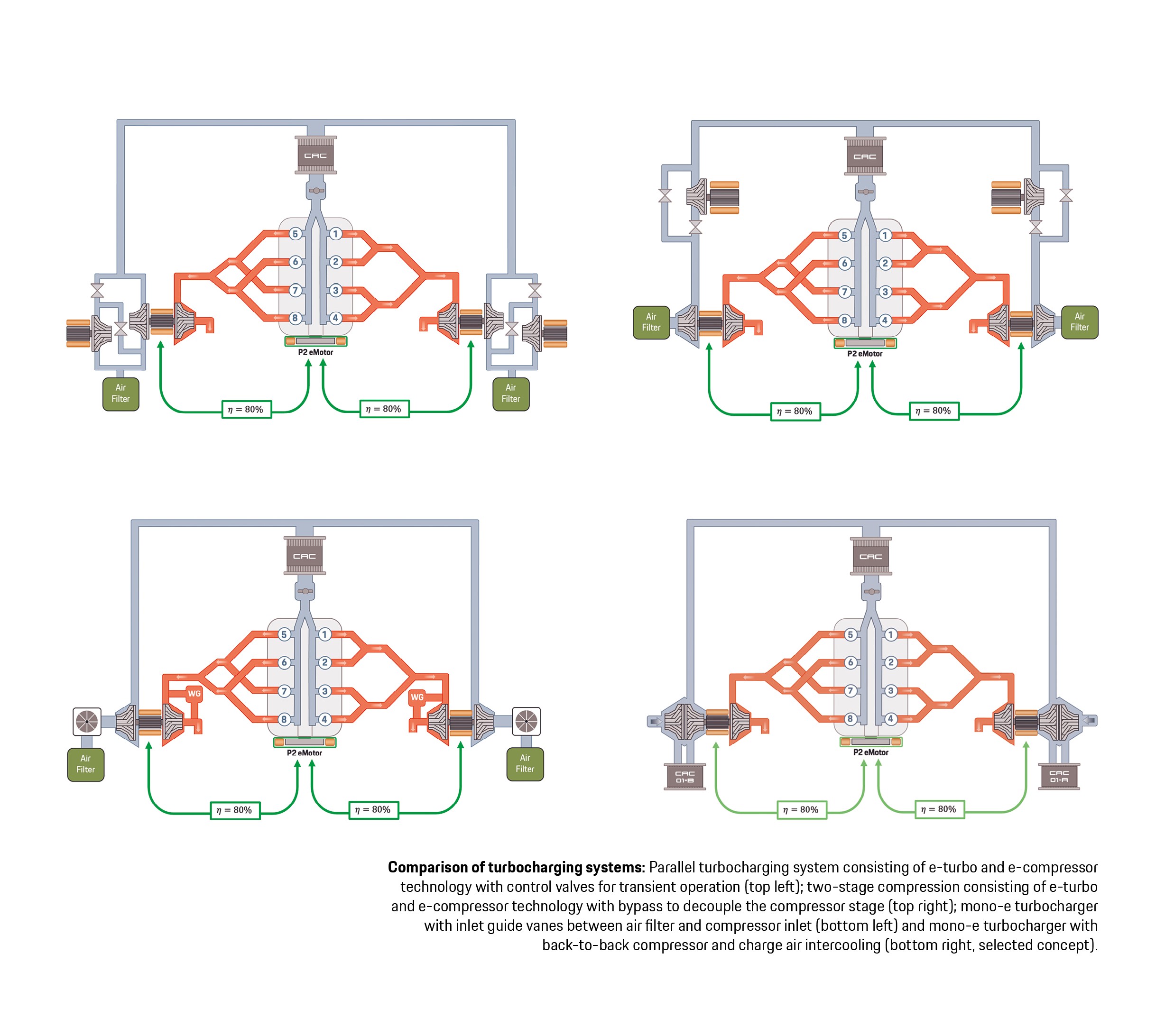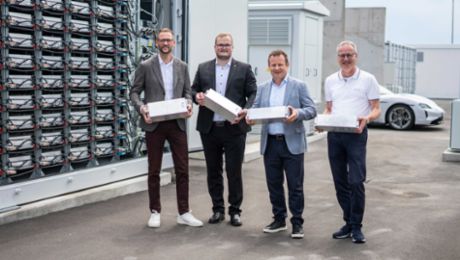Different powertrain solutions, including hybrid systems, electric drives and efficient combustion engines are currently all being developed in parallel for use in future vehicles. Hydrogen represents a potential alternative to conventional fuels or synthetic fuels (e-fuels) for use in combustion engines This was examined as part of a study on the subject by Porsche Engineering.
High-performance hydrogen engine for passenger cars
Work is currently proceeding on hydrogen engines worldwide, however this is predominantly being done for commercial vehicles with a relatively low specific output of around 50 kW per liter of displacement. “For the passenger car sector, this is insufficient. We have therefore developed a hydrogen combustion engine that aims to match the power and torque of current high-performance gasoline engines as a concept study. At the same time, we also had the objective of achieving low fuel consumption and keeping emissions at the same level as ambient air,” says Vincenzo Bevilacqua, Senior Expert Engine Simulation at Porsche Engineering. “The starting point for our study was an existing 4.4-liter eight-cylinder gasoline engine—or rather, its digital data set, since we conducted the entire study virtually using engine performance simulations.”
Modifications to the engine model included a higher compression ratio and combustion adapted to hydrogen, but most importantly, a new turbocharging system. “For clean combustion of hydrogen, the turbochargers have to, on the one hand, provide around twice as much air mass as they do in gasoline engines. On the other hand, however, the lower exhaust gas temperatures result in a lack of energy for their propulsion on the exhaust side,” explains Bevilacqua. This discrepancy cannot be resolved with conventional turbochargers. Porsche Engineering has therefore examined four alternative, particularly powerful turbocharging concepts, some of which come from the motorsport context.
All systems consist of several electrically assisted turbochargers, some of them combined with additional control valves in the air system or electrically driven compressors. “In the benchmark studies, each turbocharging system showed specific advantages and disadvantages. The choice of the right concept is therefore highly dependent on the requirements profile of the hydrogen engine in question,” says Bevilacqua. For the engine study concerned, the development team selected a turbocharging system with back-toback compressors. The special feature of this design is the coaxial arrangement of two compressor stages, which are driven by the turbine or the supporting electric motor using a common shaft. The process air flows through the first compressor, is intercooled in the intercooler and then recompressed in the second stage
With an output of around 440 kW, the hydrogen engine is on par with the original gasoline unit. In order to better assess the performance of the powertrain, Porsche Engineering tested it in a luxury-segment reference vehicle with a relatively high total weight of 2,650 kg on the Nürburgring Nordschleife—albeit entirely virtually: The drive was carried out using what is known as a digital twin, i.e. a computer-based representation of the real vehicle. With a lap time of 8 minutes and 20 seconds, the vehicle demonstrated high potential with regard to driving dynamics. Due to its chemical composition, neither hydrocarbons nor carbon monoxide are released during hydrogen combustion, and nor do particulates play a role either, of course. In terms of optimizing emissions by the hydrogen engine, the experts at Porsche Engineering therefore concentrated on nitrogen oxides. In extensive optimization rounds, they adapted the engine’s operating strategy for the cleanest possible combustion. Their approach was to keep the level of raw emissions low by means of extremely lean and therefore colder combustion, making it possible to dispense with an exhaust aftertreatment system.
“As it turned out, the nitrogen oxide emissions are well below the limits set by the Euro 7 standard currently under discussion and are close to zero over the entire engine map,” reports Matthias Böger, Specialist Engineer Engine Simulation at Porsche Engineering. In order to better contextualize the results of the emissions tests, he draws a comparison with the Air Quality Index. It is used by government authorities and other institutions as a benchmark for assessing the level of air pollution. In general, a concentration of up to around 40 micrograms of nitrogen oxide per cubic meter is equated with good air quality. “The hydrogen engine’s emissions are below this limit. Operating it therefore has no significant impact on the environment,” says Böger. In
Emissions at the same leven as ambient air
In addition to its barely measurable emissions, the hydrogen engine offers high efficiency in the WLTP measurement cycle as well as in customer-relevant cycles thanks to its lean combustion. “We have thereby fulfilled our self-imposed project goal: The development of a clean, economical and sporty hydrogen engine, across the board,” Bevilacqua concludes. The cost of a hydrogen powertrain in series production could be comparable to that of a gasoline engine. Although the turbocharger system and a number of mechanical components of the hydrogen engine are more complex and therefore more expensive, there is no need for the exhaust gas aftertreatment required for the gasoline engine under Euro 7.
The Porsche Engineering team was able to carry out all tests virtually and therefore very efficiently. The established simulation process provided the basis for this, along with the company’s extensive experience in modeling and calculation. “It took us only six months from the initial idea to the completion of the study,” says Bevilacqua. “That included fundamental work such as creating new simulation models that take into account the different chemical and physical properties of hydrogen compared to gasoline.”
Consumption advantages of up to five percent
The hydrogen engine is unlikely to enter production in its current form, but that wasn’t the goal of the project anyway. Instead, the focus was on examining the technical potential of the alternative drive technology and expanding the capabilities of existing engineering tools. “The study allowed us to gain valuable insights with regard to the development of high-performance hydrogen engines and add models and methods specifically for hydrogen to our virtual simulation methodology,” explains Bevilacqua. “With this know-how, we are ready to efficiently handle future customer projects.”
At a glance: simulated lap on the Nordschleife
Maximum speed: 261 km/h
Time: 8:20:20 Minutes
Simulated engine power: 440 kW
Info
Text first published in the Porsche Engineering Magazine, issue 2/2022.
Author: Richard Backhaus
Copyright: All images, videos and audio files published in this article are subject to copyright. Reproduction or repetition in whole or in part is not permitted without the written consent of Dr. Ing. h.c. F. Porsche AG is not permitted. Please contact newsroom@porsche.com for further information.




